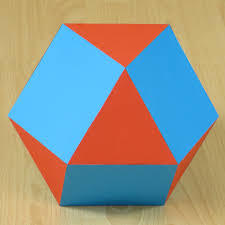Rolling an Archimedean Die
Suppose we construct a die in the shape of a cuboctahedron:

Anyone have any idea how to calculate the theoretical probability that when we roll it, it will land on a triangle as opposed to a square?
Image credit: http://www.korthalsaltes.com/
No vote yet
1 vote
Easy Math Editor
This discussion board is a place to discuss our Daily Challenges and the math and science related to those challenges. Explanations are more than just a solution — they should explain the steps and thinking strategies that you used to obtain the solution. Comments should further the discussion of math and science.
When posting on Brilliant:
*italics*or_italics_**bold**or__bold__paragraph 1
paragraph 2
[example link](https://brilliant.org)> This is a quote# I indented these lines # 4 spaces, and now they show # up as a code block. print "hello world"\(...\)or\[...\]to ensure proper formatting.2 \times 32^{34}a_{i-1}\frac{2}{3}\sqrt{2}\sum_{i=1}^3\sin \theta\boxed{123}Comments
If it were just a function of relative surface area then the probability that it would land on a square face would be 23−3≈0.634, but this of course does not take into account the mechanics of actually rolling a cuboctahedron. The square sides offer a more stable base so it would take more angular momentum to roll from this state onto a triangle, but as the square has one extra side there would be more directions in which to roll. A precise calculation would appear unlikely, so I would probably just go ahead and roll it 100 times and see how it compares to the 0.634 value. (I don't have such a solid to experiment with but if I were to make a guess, I would anticipate a square probability of in excess of 0.75.)
Log in to reply
That's an interesting experiment! I wonder what the results are like.
I've wondered if it is sufficient to project the edges onto a sphere, and then take the "sector surface area" as the relative probabilities (scale to a sum of 1). In a sense, I feel that accounts for 1) Landing on a vertex and spinning, 2) Landing on an edge, 3) Landing on a face.
(Though, this doesn't change the "actual surface area relative probabilities" by much)
Log in to reply
Next time I get my hands on a cuboctahedron, I'll definitely give it a go! (At least find the experimental value)
Depends on the thing's mass, bouncy-ness, angular momentum, and momentum. You can say the momentums are random within a certain range, but mass and bouncyness are still variables. Are you asking us to calculate it in terms of mass and bouncyness?